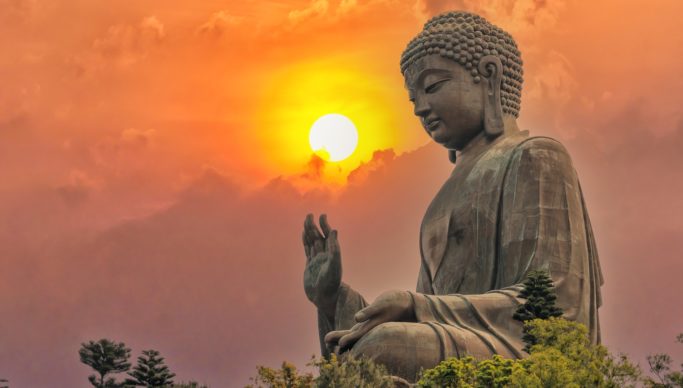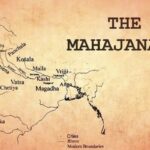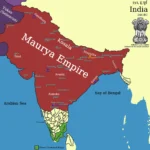Various religious movements viz. Buddhism, Jainism etc. were born and grew up in the Post-Vedic Period known as the Period of Second Urbanisation or the Age of Buddha (6th Century BC to 4th Century BC).
Buddhism
Buddha’s Life
>> Gautama Buddha, founder of Buddhism, was born in 563 BC (widely accepted), on the vaisakha purnima day at Lumbinivana (Rummindehi District, Nepal) in the Sakya Kshatriya clan.
>> His father Suddhodhana was the republican king of Kapilvastu and mother Mahamaya was a princess of Kollia republic
>> After his mother’s early death, he was brought up by his step mother and aunt Mahaprajapati Gautami.
>> His father married him at an early age to Yasodhara (Princess of Shakya dynasty) from whom he had a son Rahul.
>> Four sights—an old man, a diseased person, a dead body and an ascetic—proved to be a turning point in his career.
>> At the age of 29, he renounced home, this was his Mahabhinishkramana (great going forth) and became a wandering ascetic.
>> His first teacher was Alara Kalama (Sankhya philosopher) from whom he learnt the technique of meditation.
>> His next teacher was Udraka Ramputra.
>> At the age of 35, under a pipal tree at Uruvella (Bodh Gaya) on the bank of river Niranjana (modern name Falgu) he attained Nirvana (enlightenment) after 49 days of continuous meditation; now he was a fully enlightened (Buddha or Tathagat).
>> Buddha delivered his first sermon at Sarnath (Dear park) to his five disciples, this is known as Dharmachakra Pravartana (Turning of the wheel of law).
>> He died at the age of 80 in 483 BC at Kushinagar (identical with the village Kasia in Kushinagar district of U.P.). This is known as Mahaparinirvana (Final Blowing out).
>> Kanthaka– Budhha’s horse, Channa-Buddha’s charioteer, Devadatta– Buddha’s cousin, Sujata– the farmer’s daughter who gave him rice milk at Bodh Gaya and Other names of Buddha—Gautama (Clan name), Siddharta(Childhood name), Shakya Muni.
| Great Events of Buddha’s Life | Symbols |
| Janma (Birth) | Lotus and Bull |
| Mahabhinishkramana (Renunciation) | Horse |
| Nirvana/Sambodhi (Enlightenment) | Bodhi tree |
| Dharmachakra pravartana (First Sermon) | Wheel |
| Mahaparinirvana (Death) | Stupa |
Doctrine of Buddhism
Chatwari Arya Satyani (Four Noble Truths)
It is the essence of Buddhism.
1. Life is full of sorrow (Dukha): Sabbam-Dukkam.
2. There are causes of sorrow (Dukha Samudaya): Dwadash Nidan/ Pratitya Samputpada.
3. This sorrow can be stopped (Dukha Nirodha): Nirvana.
4. There is a path leading to the cessation of sorrow (Dukha Nirodha Gamin Pratipada) : Ashtangika Marga.
Triratna i.e. Three Jewels of Buddhism
1. Buddha (the enlightened) 2.Dharma (doctrine) 3.Sangha-(commune)
| Buddhist Council | Year | Venue | Chairman | Patron |
| 1st Buddhist Council | 483BC | Saptaparni Cave, Rajgriha | Mahakassapa | Ajatashatru (Haryanka Dynasty) |
| 2nd Buddhist Council | 383 BC | Chullavanga Vaishali | Sabbakami | Kalashoka (Shisunaga Dynasty) |
| 3rd Buddhist Council | 250 BC | Ashokarama Vihar, Patliputra | Mogaliputta Tissa | Ashoka (Maurya Dynasty) |
| 4th Buddhist Council | 98 AD | Kundala Vana, Kashmir | Chairman-Vasumitra Vice Chairman-Ashvaghosa | Kanishka (Kushana Dynasty) |
Buddhist Literature
I. Pali Texts
Tripitaka: Pitaka literally means ‘basket’ and it was called so, because the original texts were written on palm-leaves and kept in baskets. Sutta Pitaka— Buddha’s sayings, Vinay Pitaka—monastic code, Abhidhamma pitaka— religious discourses of Buddha
Milindapanho (i.e. Questions of Milinda)—a dialogue between Milinda (identical with Indo-Greek ruler Menander) and Buddhist saint Nagasena.
Dipavamsha and Mahavamsha—The great chronicles of Sri Lanka.
II. Sanskrit Texts
Buddha Charita, Saundarananda, Sutralankar, Sariputra Prakaran and Vajra Suchi- Ashwagosha; Mahavibhasha Shastra – Vasumitra; Visudhamagga, Atthakathayen and Sumangalvasini—Buddhagosha; Madhyamika Karika and Prajnaparimita Karika— Nagarjuna etc.
Sacred Shrines
>> Lumbini, Bodh Gaya, Sarnath and Kusinagar, where the four principal events of the Buddha’s life, namely Birth, Enlightenment, First Sermon and Death took place.
>> Other centres of Buddhism in Ancient India— Amaravati and Nagarjunikonda in Andhra Pradesh; Nalanda in Bihar; Junagadh and Vallabhi in Gujarat; Sanchi and Bharhut in M.P.; Dhaulagiri in Orissa; Kannauj, Kaushambi and Mathura in U.P.; and Jagadala and Somapuri in West Bengal.
>> Buddhist architecture was developed in three forms :
- Stupa- relics of the Buddha or some prominent Buddhist monks are preserved.
- Chaitya- prayer hall
- Vihara- residence
Jainism

Image Courtesy: Britannica
>> According to Jain tradition there were 24 Thirthankaras (literally Ford maker, across stream of existence) the first being Rishabhadeva/Adinatha and last being Mahavira.
>> The name of two Jain Tirthankaras- Rishabha (1st)and Arishtanemi (22nd)- are found in the Rig Veda
>> We have historical proof on only the last two – Parshwanath (23rd) and Mahavira (24th)
>> Parshwanath was a prince of Benaras who abandoned the throne and led the life of hermit and died at Sammet-Shikar/ Parshwanth (Parasanth) Hill, Giridih, Jharkhand.
His four main teachings were 1. Ahimsa (non-injury) 2.Satya (non-lying) 3.Asteya (non stealing) 4.Aparigraha (non-possession)
Mahavira’s Life
>> Mahavira was born in 540 BC in a village Kundgrama near Vaishali in Bihar.
>> His father Siddhartha was the head of Jnathrika Kshtriya clan under Vajji of Vaishali and his mother Trishala was the sister of Chetaka, the king of Vaishali.
>> Mahavira was married to Yashoda (daughter of Samarvira king) and and produced a daughter Anonja Priyadarshini whose husband Jamali, became the first disciple of Mahavira.
>> At the age of 30, after the death of his father, he renounced his family, became an ascetic and proceeded in search of truth. He was accompained by Makkhali Gosal but later due to some differences Gosala left him and founded Ajivika sect.
>> At the age of 42, under a sal tree at Jambhikagrama on the bank of river Rijupalika, Mahavira attained Kaivalya (Supreme knowledge).
>> From now onwards he was called Kevalin (perfect learned), Jina or Jitendriya (one who conquered his senses), Nrigrantha (free from all bonds), Arhant (blessed one) and Mahavira (the brave and his followers were named jain.
>> He delivered his first sermon at Pava to his 11 disciples (known as 11 Gandharas/ Gandharvas). Later, he founded a Jain Sangha (Jain commune) at Pava.
>> At the Age of 72 in 468 BC, he passed away at Pavapuri near Biharsharif in Bihar. Sudharma only one of 11 Ganadharas who survived after the death of Mahavira.
Doctrines of Jainism
Triratna i.e. Gems of Jainism
The aim of existence is to attain through the triratna of
1. Samyak Shradha/ Viswas (Right faith): It is the belief in Thirathankaras.
2. Samyak Jnan (Right knowledge): It is the knowledge of the Jain creed.
3. SamyakKarma/Acharana (Right action/conduct): It is the practice of the 5 vows of Jainism.
Pancha Mahavaratas i.e. Five Vows of Jainism
Five vows of Jainism are: 1. Ahimsa (non-injury) 2. Satya (non-lying) 3. Asteya (non-stealing) 4. Aparigraha (non-possession) 5.Brahmacharya (chastity). The first four vows were laid down by Parshwanath. The fifth one was added by Mahavira.
Types of Knowledge
There are 5 types of knowledge: 1. Mati jnana-Perception through activity of sense organs, including the mind 2.Shruta jnana– Knowledge revealed by scriptures 3. Avadhi jnana-Clairvoyant perception 4.Manahparyaya jnana-Telepathic knowledge 5. Keval jnana-Temporal knowledge or Omniscience
| Jain Council | Year | Venue | Chairman | Patron |
| 1st | 300 BC | Patliputra | Sthulabhadra | Chandragupta Maurya |
| 2nd | 512 AD | Vallabhi | Devardhi Kshmasramana | — |
Jain Literature
>> The sacred literature of the Svetambaras is written in a type of Prakrit called Ardhamagadhi Prakrit, and may be classified as follows : 1. 12 Angas 2. 12 Upangas 3. 10 Parikarnas 4. 6 Chhedasutras 5. 4 Mulasutras 6. 2 Sutra-Granthas.
>> Besides this, the important jain texts are:
- Kalpasutra (in Sanskrit)- Bhadrabahu 2. Bhadrabahu Charita 3.Parishishta Parvan (an appendix of Trishashthishalaka Purush) Hemchandra.
Sects of Jainism
In298BC, there was a serious famine in Magadha (South Bihar) leading to a great exodus of many Jain monks to the Deccan and South India (Shravanbelgola) along with Bhadrabahu and Chandragupta Maurya. They returned back after 12 years. The leader of the group, which stayed back at Magadha was Sthulabhadra. When the Jains (Bhadrabahu and others) returned from South India, they held that complete nudity be an essential part of the teachings of Mahavira, while the monks in Magadha began to put on white clothes.
>> Thus arose the two sects Shvetambaras (white clad) and Digambaras (sky-clad).
1. Shvetambaras (i,e. those who put on white robes) — Sthulabhadra
2. Digambaras (i.e. those who were stark naked — Bhadrabahu.
Examples of Jain Architecture
- Gumphas i.e. Caves e.g. Hathigumpha, Baghagumpha etc., Udaigiri and Khandagiri (Orissa) – Kharvela
- Dilwara temples e.g. Vimalavasahi temple, Tejapala temple —Mount Abu (Rajasthan)
- Temples— Giranar and Palitana (Gujarat)
- Temples e.g. Pavapuri temple, Rajagriha temple – Bihar
- Statue of Gometeshwar/Bahubali—Shravanbelgola (Karnataka).



